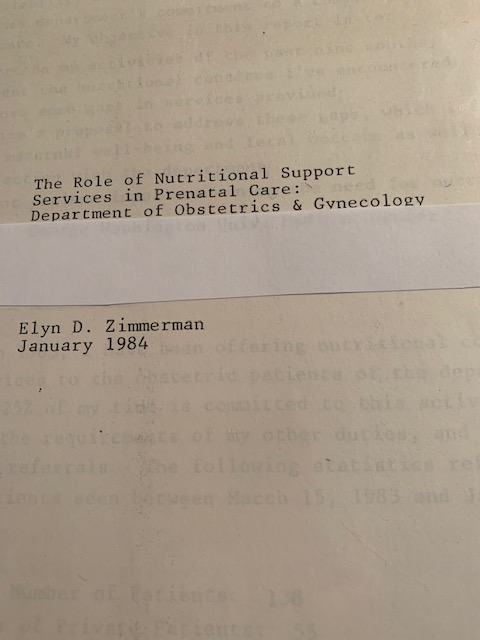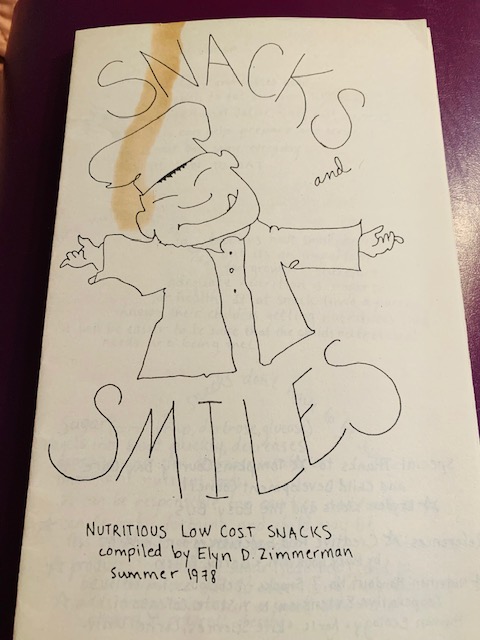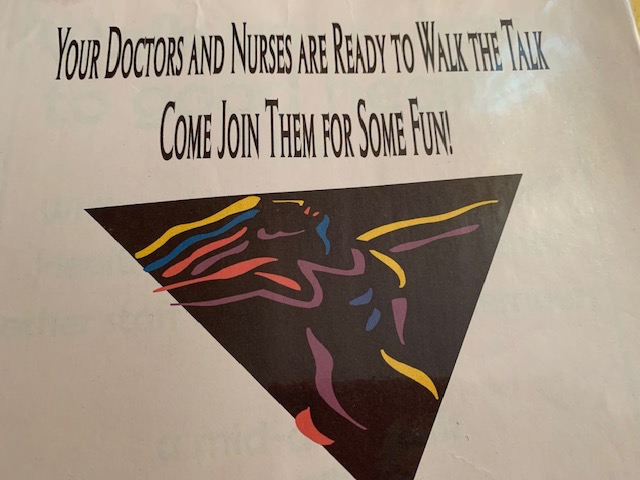A few years ago, while serving as a resource person for a national food security organization, I responded to an inquiry. It was from a woman doing related work for a small non-profit. Though I was then staying and working out of state, she was from a community very close to my home–so there was a welcomed familiarity in connecting with her.
When I returned home, I made the lovely thirty-five minute drive down beautiful back roads to meet with her. Sitting together in her office–a large warehouse space–she described her programs related to food access, nutrition education, and Produce Prescription Programs. Having done the same work myself, I was impressed with her sophisticated and creative approach, and the success of her efforts. She had been in this job for four years and had accomplished a lot in a rural area with limited resources. And, though her face was largely hidden behind a Covid mask, I realized that she had obtained this professional maturity by, at best, her mid-thirties.
We stayed in touch, and a few months later she informed me she was moving on to pursue an unrelated opportunity, and I wished her well. Having become linked on LinkedIn, I noticed that she identified herself as a Public Health Innovator. This intrigued me. While I did not doubt her right to ascribe that title to herself, I wondered what being such an innovator would entail, and might I, with a few decades on her, have any claim as such. And so, I began an inventory of my own path.
Let me acknowledge that by all measures, and certainly by today’s standards, my efforts were itsy-bitsy, teeny-weeny, tiny. I have been a very small fish, in a very small pond, with little personal agency to swim out into larger waters. I had no funds, grants, or extra supports. Maybe just some supervisors who let me do some things–or didn’t stop me. I just wanted to help those I was serving. My reach was small, and the sustainability of my projects limited, but I did possess some type of fins and gills, impelled to create something to fill a need that had lacked attention or address in its time.
What turned into my career began in the early 1980s, a period when the government, still in the wake of the ‘War on Poverty’, was crafting its national nutrition programs to bluntly address abject hunger, the effects of a few decades of corporate interests controlling the American diet were seriously taking their toll but had not yet reached full crisis level, and the folks in the natural foods movement were making the connection between diet quality and personal and societal health–but they were quite marginalized.
Margarine was still cool, soda drinks were just starting to supersize, the term ‘wellness’ was not yet coined, and no one knew were were a mere decade away from an obesity and chronic disease red-alert. Likewise, mimeograph machines were just surrendering to Xerox, typewriters to word processors, and print materials knew not of the worldwide web.
Arriving at this cusp of nutritional awakening, I began to work my way through a number of different community and clinical settings, propelled by geographic moves related to early adulthood and marriage. At each stop, I was witness to emerging issues, and being in unchartered waters I had a modicum of freedom to make things up–or should I say, find some innovative solutions.
I first stepped out of the box in 1980, when as a WIC Nutritionist in the federal program that was then only about five years old, I arranged to walk a group of moms down the street from the WIC clinic site to a little whole-grain bakery for a tour–certainly this was not within normal operating procedures. This was before there was any widespread, soon-to-be earth shattering news about the ills of Wonder Bread. But I had gotten the memo, and I guess thought this was an opportunity for an interesting, educational outing. Though my intention seemed rather innocent or naive, I guess something deeper was rising within me that would inform my future endeavors.
And so I swam forth through the next four decades, trying some innovative things largely within various work settings but beyond the requisite duties of my role. Here are just some of them:
The Nineteen Eighties
Presented a paper I had written entitled, The Role of Nutritional Services in Prenatal Care, to the medical team in the Department of Obstetrics & Gynecology at a large, prestigious university medical center. (Yes, young me!). This forwarded the integration of nutritional assessment and counseling into prenatal care within that practice and enabled me to later provide specialized nutrition support to pregnant women in other settings. (1984)
Presented workshops on nutritional approaches to women’s health concerns in various workshop settings. Many of these concerns had not been properly understood until the mid-1900s and were only gaining wider recognition and support around the 1970s due to the visionaries and feminists of that period. (1985-1987)
The Nineteen Nineties
Developed a cooking class for pregnant teenagers while working for another WIC Program and observing the demise of home-prepared meals in a peak period of teen pregnancies. I enjoined the collaboration of a local Cornell Cooperative Extension agency and a community food pantry. Participants received a free bag of groceries at each class. (1994)
Implemented the following at a Community Health Center to provide greater options for well being to a low-resourced community: (1997-2001)
Physician-Nurse Team-led walking program and nutrition classes for staff and patients
Center-based Yoga Class Series taught by certified Yoga Teachers–there was a waiting list for the class
Coupon Program and Cooking Demonstrations with the local food-coop
The Two Thousand Aughts
Invited one of the nation’s first mobile produce vans intended to bring quality, discount-priced produce to underserved neighborhoods to make a weekly stop at a Community Health Center to reinforce the notion of ‘food as medicine’. This popular stop served a wide-range of clients, staff, and medical providers and raised awareness about food insecurity. (2008)
Provided to my clients (on a very small scale) low-cost, non-perishable nutritious food samples boxed in cardboard Chinese Food containers. They included sardines, beans, oatmeal, teas, spices–along with cooking instructions. These were essentially a precursor to healthy meal boxes available today. (Back then I wished I had a way to get funding to expand that idea.) (2010)
Expanded eating disorder services and resources at a college. Also, helped initiate changes to support more sustainable practices and local food sourcing for the college’s Dining Services. (2007)
The Twenty Teens
Developed and administered the clinical component of one of the nation’s earliest Produce Prescription Programs. Conducted a Program Evaluation and the Program’s results were published in a Public Health Journal. (2011-2013)
Designed a Diabetes Education Program that had included a diabetes-friendly meal that was prepared together by some of my patients in the Program who were experienced cooks–mainly elderly black ladies who had each fed countless mouths and who could serve an army or at least a filled church. The program also included a dance segment led by a local Latin Dance teacher. (One of the program attendees became a member of the teacher’s traveling dance troupe.) (2012)
Solicited local businesses to donate breastfeeding supplies to a Community Health Center for nursing mothers in honor of National Breastfeeding Month. (2013)
In the mid-Twenty Teens my work took me out of direct care environments and into more Program Management roles. By this point, innovation was largely being measured by technology-based advances where I was less well-equipped–though I still pushed my grassroots efforts where I could. My inspirations and innovations grew out of having sat with thousands of eaters from around the globe and from all walks of life, a plethora of pregnant moms, a couple of hundred college students eating their way from adolescence to adulthood, and a few dozen elementary-aged school children who knew more about food and life than you might think. I looked for every available resource to support them all as best I could, created partnerships when possible, and came up with new solutions when necessary.
Surreptitiously I removed infant formula promotional materials from the ‘free’ gift bags and magazines targeted to pregnant women and quietly encouraged vending machine vendors to replace the most nefarious offerings with others less harmful to the human organism. I produced lots of nutrition education materials and wrote many newsletter articles. And then, I embarked on documenting in 125+ blog posts ‘the intimate art of eating in response to the personal and cultural milieu’. From my work chairs to my pitter-patterings about, I bore witness to much of the difficulties we are now experiencing in even more extreme ways–demanding a more robust and urgent response. My writings presaged much of what we are confronting and I invite you to to search my site for my insights on any number of nutritional matters including breastfeeding, eating disorders, toxic food systems, child health, obesity, racism, health inequities, nutrition insecurity and food marketing. Gosh, things got a lot more complicated than just whole wheat bread.
Looking back, I acknowledge that I did a lot for a small fish. I used to say that one thing I would not do was to dress up like a fruit or vegetable, but I will don the Public Health Innovator Hat, at least for a moment. I still have a list of things that I would love to see be done, so as I ease out of this work, I’d be glad to share my ideas. Also, feel free to build upon my efforts if you can appreciate their value. Finally, fellow innovators, keep up the good work. If I catch sight of your schemes, I will be glad to celebrate them.
Thank you for listening, sharing, following, and supporting my writing. Please subscribe in the sidebar to receive notice of new posts. Comments and greetings always welcome.
Be well. Take care. Stay safe. Let’s heal.
In health, Elyn
P.S. OK. Here is one of my ideas. Let’s implement a program for vulnerable senior citizens similar to the Women, Infant and Children (WIC) Program. Maybe just an add-on program called WICS.
And, here are some other important insights and innovative ideas shared by Food Bank News regarding collaborative efforts working with underserved populations with globally-based examples.

My Plate Haiku
Craving for pickles
And German Chocolate Cake
My friend is pregnant. by Gretchen



Wonderful recap. I’m sure there was so much more.
LikeLike
Elyn, you are amazing ! Susan
Sent from my iPhone
>
LikeLike
Elyn, I appreciate the work you have done from your accounts transcending decades, it is awesome and I wish I could take up the mantle and continue. I would appreciate also to see what you have in mind that you feel you have not tackled…… I am just starting and the gap I look to fill is on public health education. I would like to see people empowered in health literacy, nutrition, and wellness. Looking at when you started your initiatives to make small changes, I am challenged.
Thank you so much for letting us read what you have done and learn that every small effort counts!
LikeLike
Dear Catherine, Thanks so much for your comment. Yes, it is work that requires much idealism and caring which I am sure you have. You touch on two important things. One is health literacy which I think has room to be addressed in new ways including ‘plain language’. The other is empowerment which also goes along with enabling. There are many ways that we now have more opportunities for providing both–but we need a big societal shake up as well. You may contribute to both! Many of our individual struggles related to health are due to what has been fostered upon us. Always acknowledge that. My best to you!!!
LikeLiked by 1 person
Not a small fish.
Your servings fill a large dish.
And your offerings are quite delish.
LikeLike
Dear Dr. Sue(ss), Thank you. Some efforts did include some Omega-3s, like when I bought Chinese Food containers and filled them with low-cost, high-nutritious foods as sample kits for my patients. These included cans of sardines, along with some packets of oatmeal, beans, cinnamon, herbal teas, and maybe something else that I can’t remember. If I was not a fish and instead knew how to be a venture capitalist, I would have marketed that idea to some corporate giant and become rich.
LikeLike
Thank you ,Elyn, I am hope to make a mark!
LikeLike